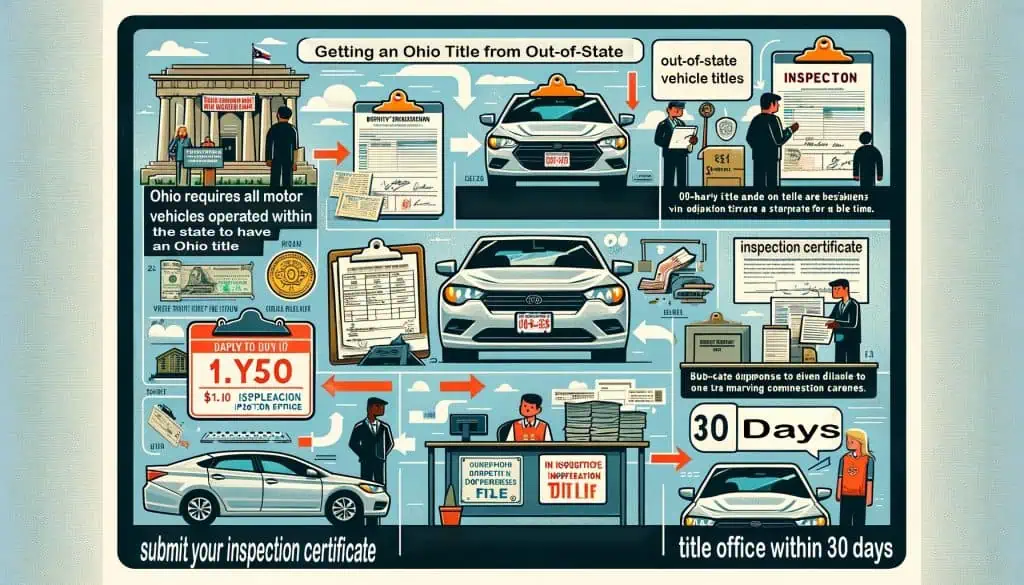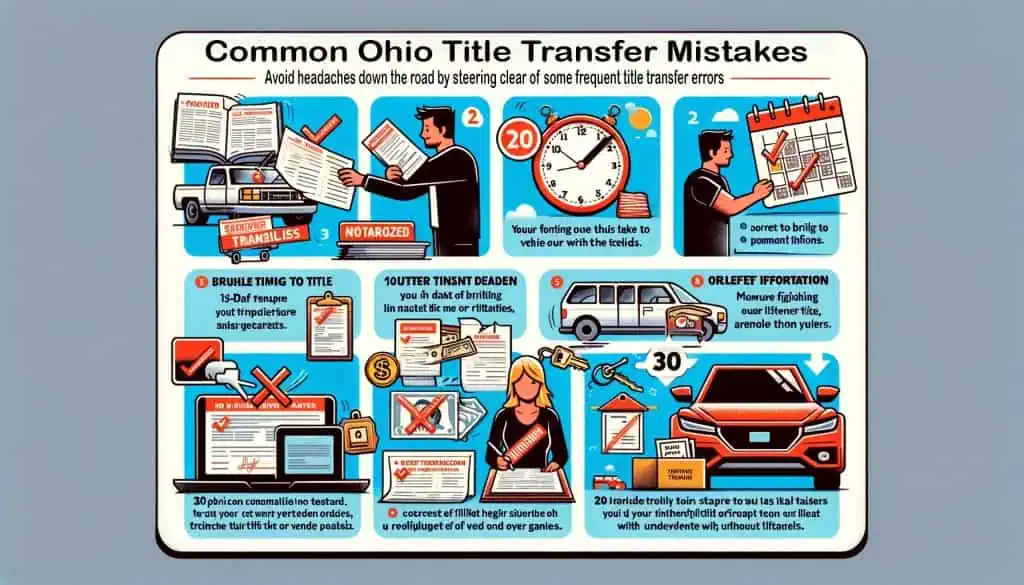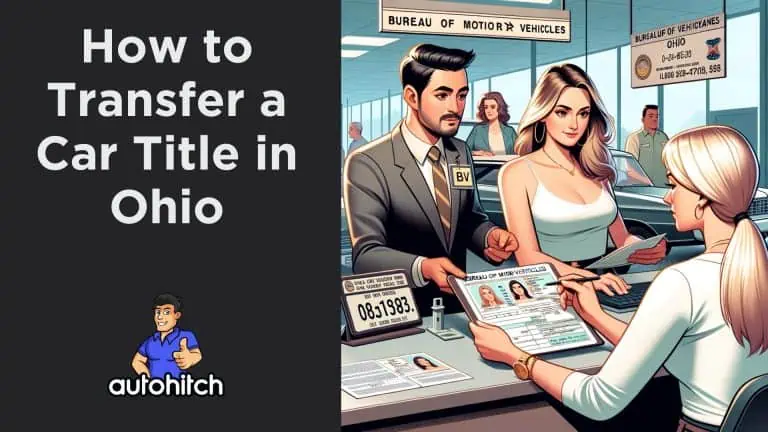Whether you’re buying, selling, inheriting a car, or moving to Ohio, you’ll need to know the proper steps for titling a car correctly according to OHIO State Law.
In this detailed guide, we cover everything you need as an Ohio resident when transferring car ownership.
Key Takeaways
- Both buyers and sellers have duties when legally transferring title ownership
- Most title transfers require going to the local County Clerk of Courts Title Office
- Documents like a properly assigned title, identification, and payment for fees are mandatory
- Additional requirements may apply for duplicate titles or out-of-state vehicles
- Title transfers usually take 1-2 hours if you have prepared correctly
Relevant Articles To Read:
- How To Transfer a Car Title in Ohio To A Family Member
- Where To Get a Car Title Notarized
- How to Transfer A Car Title To A Family Member
- Two Names On Car Title How To Remove One
- What Is an Open Title on a Used Car
Table of Contents
What is a Car Title?
An Ohio Certificate of Title is a legal document that states vital details about a vehicle and most importantly, the legal owner’s name. Titles prevent theft and provide proof of ownership in Ohio.
Without a correctly transferred title, you don’t legally own the car you purchased or sold.
Overview: When is a Title Transfer Necessary in Ohio?
There are several common situations that require transferring a car title properly in Ohio:
- Buying or Selling a Vehicle: Title transfers to assign legal ownership are mandatory.
- Inheriting a Car: Beneficiaries must transfer inherited vehicle titles into their names.
- Gifting a Car: Even gifting requires a formal title ownership transfer process.
- Moving to Ohio: New residents have 30 days from moving to Ohio to transfer out-of-state titles.
In Ohio, anyone operating a motor vehicle must carry proof of ownership readily available inside the car, like the title or temporary permit from auto dealerships.
| For the Seller | For the Buyer |
|---|---|
| Pay off any existing liens and obtain lien release | Ensure seller completed title transfer section properly |
| Fill out title transfer section with buyer info, sale date, price, mileage | Gather title certificate, title application, ID, payment for fees |
| Sign title transfer section | Get title application signature notarized like seller did |
| Get signature on title notarized | Schedule appointment at title office within 30 days |
| Make copies of title front and back for records | Bring documents to title bureau and submit for new title |
| Remove license plates after transferring ownership | Pay title transfer fee and applicable sales tax |
What Does the Seller Need to Do to Transfer an Ohio Title?

As a seller, you have critical responsibilities when transferring ownership to legally sell your car in Ohio.
Here are the steps sellers must complete before physically handing over keys and the title itself to buyers:
- Pay Off Any Loans First: If you still owe money on the vehicle through a lien or loan, you must finish paying it off first and obtain a lien release letter.
- Fill Out the Title Correctly: On the back of Ohio car titles is an ownership transfer section. Accurately enter the buyer’s name, current address, date of sale, price paid, and odometer reading. Triple check for mistakes!
- Sign Your Title: Sign the title transfer section on the back after you’ve double checked. But do not sign it until after the buyer has filled in their information.
- Get Your Signature Notarized: In Ohio, owners must get their title signatures notarized before transferring. Most banks have free title notarization services.
- Keep Records: Make copies of the front and back of the title before transferring it. This provides records if you need proof you transferred ownership later.
- Remove Your Plates: Take back your license plates after selling your car when you transfer the signed title. The new owner cannot legally drive the vehicle without titling it first anyways.
By following these vitally important steps, sellers uphold their legal duty to transfer vehicle titles properly to buyers under Ohio state law. Avoid penalties and headaches down the road by doing it right the first time.
What Does the Car Buyer Need to Do to Transfer an Ohio Title?
The buyer has more complex responsibilities when title transferring in Ohio. But it only requires a few hours total across 1-2 trips to the Ohio BMV title office if you’re prepared. Here’s exactly what you need to legally transfer an Ohio car title fully into your name as a buyer:
1. Get the Title from the Seller
You can’t do anything until the seller provides you with the physical title certificate document for the vehicle with the transfer section completed on the backside.
Ensure the seller accurately captured all the details like sale date, price paid, odometer reading and your name/address when you receive it.
2. Apply for a Title Transfer
The next vital step is completing the title transfer application process through your local County Clerk of Courts Title Office, aka the Ohio BMV Title Office.
You must finish the title transfer within 30 days of the sale date written on the title by the seller according to Ohio law. After 30 days, you’ll pay $5 late fees.
To apply for the new title fully in your name, gather everything you’ll need to bring:
- Original Title: The original title signed over to you from the seller. Photocopies won’t work!
- Title Application: Print the Title Application from the BMV site and fill it out fully. Get your signature on the application notarized just like the seller did.
- Identification: Bring valid ID like your driver’s license, passport, etc.
- VIN Inspection: For out-of-state vehicles, you need a VIN verification from a licensed Ohio dealer first.
- Payment: Bring payment to cover the title transfer fees and any sales tax you owe based on the purchase price. Ohio charges $15 for new titles plus other minor fees.
With all those documents ready, visit your local title office in person and submit the paperwork to transfer ownership. If there are multiple owners, you all must go together to handle the transaction at once.
After 1-2 hours at the title office, you’ll receive your new Ohio Certificate of Title with your name listed as the sole legal owner!
But what about some special title transfer situations in Ohio?
Transferring Car Titles Upon Death or Inheritance
When inheritance is involved, the process differs slightly since you’ll need to provide:
- The original title
- Certified copy of the death certificate
- Surviving Spouse Affidavit if you’re the widow or widower
And if the estate is probated, the court first decides who inherits ownership based on the will or lack thereof.
So consult a probate administration lawyer for assistance ensuring the car title’s property transfer goes smoothly into the name of whoever inherited the vehicle.
Getting an Ohio Title from Out-of-State

Since Ohio requires all motor vehicles operated within the state to have an Ohio title, owners moving here must transfer out-of-state vehicle titles.
The process to convert an existing title into an Ohio title includes these extra steps:
- First, make a title inspection appointment for your car at any Deputy Registrar’s office to verify the VIN. There’s a $1.50 inspection fee.
- Next, gather the other above-mentioned documents needed to transfer an Ohio title.
- Finally, submit your inspection certificate and paperwork to the title office within 30 days before the inspection expires.
So new Ohio residents don’t get an extension when titling their cars locally. Take action right away since you only have 1 month after establishing residency here to obtain your new title from the BMV!
How Much Does it Cost to Transfer an Ohio Car Title?
Fortunately, transferring ownership through new Ohio car titles or out-of-state conversions costs under $40 typically. Here are the current baseline fees:
- $15 Title Transfer Fee: Charged on all title ownership changes in Ohio
- $15 New Title Fee: Applies to new Ohio title certificates issued
- $15 Duplicate Title Fee: For lost or damaged title replacements
- $5 Late Transfer Penalty: If not transferred within 30 days of sale
- $1.50 VIN Inspection: For verifying out-of-state vehicles
However, you also must consider paying sales tax on the vehicle’s purchase price in your county on top of the title and transfer fees.
This taxable amount is set by your local jurisdiction.
Find your county’s total sales tax rate by searching on the Ohio Department of Taxation site. Calculate what you’ll roughly owe ahead of time so your title office visit goes smoothly!
Common Ohio Title Transfer Mistakes

Avoid headaches down the road by steering clear of some frequent title transfer errors:
- Not getting your signature notarized
- Letting the 30-day transfer deadline lapse
- Forgetting to bring your photo ID or payment info
- Filling out any vehicle or owner details incorrectly
- Transferring titles with liens still attached
Cross every T and dot every I throughout the process using the steps covered above so your title application gets handled promptly.
How Can an Ohio Title Service Help?
Between managing lien releases, carrying outdated paper titles around, and making title bureau appointments, transferring Ohio titles demands lots of time and paperwork.
That’s why third-party car title service firms exist to handle everything for you from the comfort of home for reasonable fees. They prepare correct forms, file BMV paperwork, and ensure speedy title transfers.
So if you want to skip the title headache, consider outsourcing the process to an experienced professional service. Learn more about how CarTitles.com saves people hours on Ohio title transfers for cars bought or sold locally or from out-of-state.
Frequently Asked Questions About Transferring Ohio Car Titles
Still, have more questions about properly changing vehicle ownership in Ohio? Here are answers to some commonly asked questions:
How do I transfer a car title to someone else in Ohio?
You or the buyer must complete the title transfer application and forms through an Ohio BMV office within 30 days along with the required documents and fees. The title can’t be legally signed over without handling the formal transfer process.
Do both owners have to go to transfer an Ohio title?
Yes, unless one provides certified power of attorney documentation. All owners must sign to transfer, so they typically should do so simultaneously in-person at the title bureau.
What documents do I need to transfer my Ohio car title?
Gather the current title certificate, application for a new title, ID, payment, and any other forms like death certificates or inspection certificates that apply to your situation before visiting the BMV office.
My Final Thoughts
By staying up-to-date on the latest processes, costs, and requirements, you can take the hassle out of correctly transferring vehicle ownership in Ohio yourself. Or you can leave it to the professionals if handling the title process on your own seems too demanding.
Either way, we hope this guide gave you everything you need to know about legally changing Ohio car titles! Let us know if you have any other questions.



